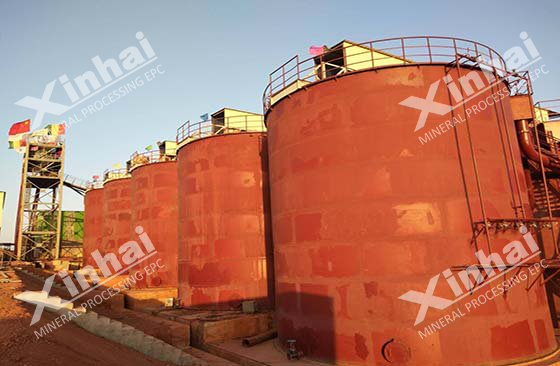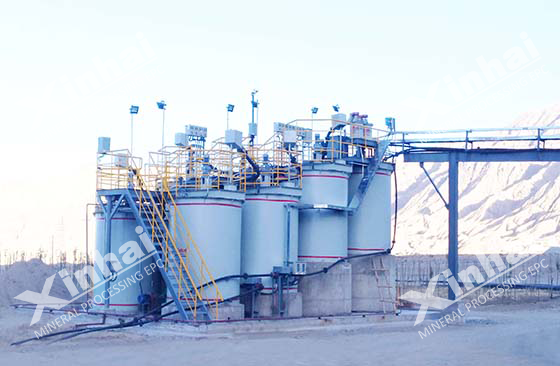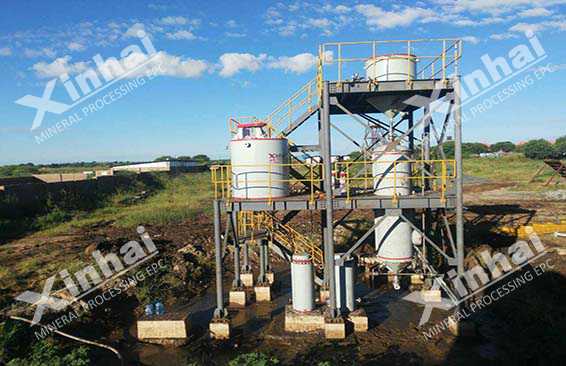Cyanidation is one of the important methods to extract the gold. With the development of easy-to-leaching gold mine, the recovery of hard-to-leaching gold mines has become a concern.There are some minerals that can affect the efficiency of cyanidation process in the hard-to-leaching gold ores. The obstruction methods and the influence degree of those minerals changes as the ore types. From this article, you can know about the types of minerals which hinder the gold leaching efficiency. At the same time, here are some solutions you can refer to.

1.Iron sulfide minerals
There are two common iron sulfide minerals in the gold ores. They are pyrite and phrrhotite. The pyrite in the ore pulp will be oxidized to ferrous sulfate which will react with cyanide to produce the ferrocyanate. During the reaction process, a large amount of sodium cyanide extract will be consumed so as to affect the gold leaching efficiency. Meanwhile, the pyrite will also become soluble sulfide, colloidal sulfur or thiosulfate under the action of lime and air. The process will consume the oxygen, which will influence the gold leaching efficiency. The phrrhotite is easy to react with cyanide to produce the thiocyanate. As mentioned above, the ferrous sulfate produced by oxidation can react with cyanide to form ferrocyanate. Therefore, the iron sulfide minerals interfere with the cyanation process of gold greatly.
2.Arsenic-containing minerals
There are three common arsenic-containing minerals: toxic sand, orpiment and realgar. Among them, the toxic sand is a more common arsenic-containing minerals. The toxic sand in the alkaline solution will be oxidized with the action of air which will consumes a large amount of oxygen. This oxidation process will affect the cyanide process. Orpiment and realgar will form compounds such as thioarsenite in the strongly alkaline solution used for cyanide immersion. Thioarsenite can also react with the oxygen in the solution to form arsenite, which consumes a lot of oxygen in the mineral slurry. What’s more, when arsenic minerals are oxidized in solution, an arsenic compound (smelly scallion stone) film is formed on the surface of gold particles, which directly hinders the contact between gold and cyanide and affects the dissolution of gold.

3. Copper-containing mineral
Sodium cyanide solution can dissolve almost all copper minerals, but the dissolution speed of copper sulfide minerals is slower than that of copper oxide minerals. Among the copper oxide mineral, the chalcopyrite is relatively stable. Because copper in copper minerals is mostly bivalent, which is very unstable in sodium cyanide solution. Divalent copper oxidizes cyanide and is itself reduced to monovalent copper and combines with the cyanide in the pulp to form a complex. Under the condition of pH value and sodium cyanide concentration used for cyanide extraction, the main product is mainly copper cyanide complex of Cu (CN) 2-, and thiocyanate is also formed. The common copper oxide mineral is malachite, which is easily dissolved in sodium cyanide solution. This will significantly increase the consumption of cyanide. It can be seen that copper minerals have a great impact on the cyanide gold extraction process.
4.Lead minerals
A small amount of lead minerals can promote the cyanide leaching of gold mines, but a large number of lead minerals will affect the gold leaching efficiency. The main lead-containing minerals in the gold mine are galena (PbS) and lead alum (PbSO4). The galena will become lead alum after oxidation.Lead alum can produce alkaline lead acid salt in a strong alkaline solution, which will react with the cyanide in the solution to produce insoluble strong alkaline cyanide.

5.Antimony-containing mineral
Stibnite is the main antimony-containing sulfide mineral. Its harm in the cyanide leaching process is similar to that of the orpiment. It is easy to dissolve in a strong alkaline solution and produce thioantimonite, and then further oxidized into antimonite. In addition, it is also found that the negatively charged stibnite colloidal particles in the alkaline cyanide solution were adsorbed on the surface of the gold particles so as to hinder the dissolution of the gold.
6. Carbon substances
Gold mines contain carbon substances including inorganic carbon and organic carbon (such as humic acid). When the gold ore contains carbon substances, it will adsorb the dissolved gold in the cyanide solution, reducing the leaching rate of gold in the solution. This phenomenon is known as "gold robbery".
In addition to the above minerals, there are also some other minerals that can cause the difficulties when leaching the gold ores. For example, Substances in the form of telluride make it difficult to dissolve gold in cyanide solution. However, this type of gold mine is relatively rare.
For the above minerals, the method to reduce their impact on gold leaching is mainly started from the following two aspects.
One is the pretreatment before cyanidation process. The pretreatment is to oxidize and decompose main mineral (mainly sulfide minerals) in the gold mine. It can not only expose the coated gold, but also remove the components which will affect the gold leaching. The other is to inhibit or eliminate interference with the process of cyanide by harmful components by adding certain chemicals or reagents. The pretreatment process is common, which includes oxidative roasting method, wet pressurized oxidation method and so on.
In actual production, there are some common solutions. The details are as follows.
1. Gold ore containing copper will be predipped in copper.
2. For gold mines containing arsenic minerals and carbon plastes, they can apply roasting method before cyanidation.
3. Gold mines containing lead minerals can be removed by means of flotation separation
It should be noted that the solution needs to be formulated scientifically and reasonably through tests according to the conditions of ore components, so as to avoid unnecessary economic losses and resource waste.
In conclusion, we can find that the components hindering gold mine leaching are more and complex.The mineral components are different in each ore deposit. In the actual production, it is suggested that mine owners do a good job in beneficiation test and make beneficiation plans according to the characteristics of the deposit to obtain the ideal beneficiation effect.